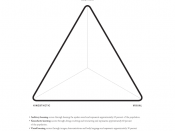Background to the StudyChange is unstoppable. We either adapt or fossilize. This is the fact that applies, whether we are talking about change in our private or public lives. Change not only affects social institutions, like the family, but the world of work and our interpersonal and economic lives as well. In our Jamaican society today, unlike many years ago, it is notable that the society throughout the years has changed and gradually developed into a culture that emphasizes individualism- a ÃÂme, myself and IÃÂ phenomena. Many people tend to be selfish and do not have a sense of solidarity, unity or cohesiveness. Some people refuse to collaborate with others and the continuous upsurge of political tribalism has added significantly to this problem.
Lack of collaboration is evident in both major political parties, each sticking to its own agenda- caring not who gets hurt in the process, as long as the party is not grossly affected in the voter representation.
The constant display of selfishness and aggression between opposite party members and supporters by verbal and physical abuse is depicted via the television, newspapers and the radio. Most if not all peace treaties have been dismantled, while communities are constantly fighting against each other and the country is hemorrhaging. Children live what they learn and the poor societal behaviours which exist not only among politicians, but also in the wider society are being displayed in the environs of the classroom on a regular basis.
In our Jamaican school setting, the teacher most often allows students to work independently. This method allows the student to work on his or her own. However, it seems to develop a tendency of selfishness at times. The researcher has observed that some students showed a lack of interest in the activities when placed in groups, they preferred to work independently.
It was also observed by the researcher that students are required most of the time to work individually. Students often become frustrated and disinterested because of this monotonous method. It then becomes necessary for the teaching learning strategies of the teacher to be changed or improved in order to facilitate a conducive classroom environment in which students will be eager to learn and will be motivated to achieve more through collaboration.
Since having this experience, the researcher became interested in using Collaborative Learning to improve studentsÃÂ academic performance. It is also evident thatwhen one interrelates with his/her peers it encourages good human skills, promotes positive interaction, and social cohesiveness. Students most often work better with their peers, so teachers should encourage some amount of collaborative learning.
BIBLIOGRAPHYBeaumont, D. (1997). Notes and Queries: G. Bell PublicationCollier, K. A. (2000). Collaborative Learning and the "conversation of mankind."College English, 46(7), 635-652.
Cramer, W. & Smith, K. Eds. (2000). New paradigms for college teaching. Edina,MN: InteractionCreswell, F. (2005). Complete Vocabulary: Oxford University PressEby, L. & Lunsford, A. (1994). Singular texts/plural authors: Perspectives oncollaborative writing. Carbondale, IL, Southern Illinois University Press.





